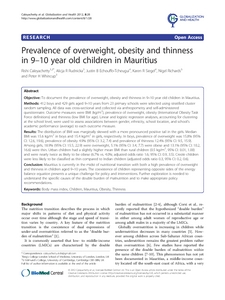Caleyachetty, R; Rudnicka, AR; Echouffo-Tcheugui, JB; Siegel, KR; Richards, N; Whincup, PH
(2012)
Prevalence of overweight, obesity and thinness in 9-10 year old children in Mauritius.
Globalization and Health, 8 (28).
ISSN 1744-8603
https://doi.org/10.1186/1744-8603-8-28
SGUL Authors: Rudnicka, Alicja Regina Whincup, Peter Hynes
![[img]](https://openaccess.sgul.ac.uk/100488/1.hassmallThumbnailVersion/1744-8603-8-28.pdf)  Preview |
|
["document_typename_application/pdf; charset=binary" not defined]
Published Version
Download (211kB)
| Preview
|
Abstract
OBJECTIVE: To document the prevalence of overweight, obesity and thinness in 9-10 year old children in Mauritius.
METHODS: 412 boys and 429 girls aged 9-10 years from 23 primary schools were selected using stratified cluster random sampling. All data was cross-sectional and collected via anthropometry and self-administered questionnaire. Outcome measures were BMI (kg/m2), prevalence of overweight, obesity (International Obesity Task Force definitions) and thinness (low BMI for age). Linear and logistic regression analyses, accounting for clustering at the school level, were used to assess associations between gender, ethnicity, school location, and school's academic performance (average) to each outcome measure.
RESULTS: The distribution of BMI was marginally skewed with a more pronounced positive tail in the girls. Median BMI was 15.6 kg/m2 in boys and 15.4 kg/m2 in girls, respectively. In boys, prevalence of overweight was 15.8% (95% CI: 12.6, 19.6), prevalence of obesity 4.9% (95% CI: 3.2, 7.4) and prevalence of thinness 12.4% (95% CI: 9.5, 15.9). Among girls, 18.9% (95% CI: 15.5, 22.9) were overweight, 5.1% (95% CI: 3.4, 7.7) were obese and 13.1% (95% CI: 10.2, 16.6) were thin. Urban children had a slightly higher mean BMI than rural children (0.5 kg/m2, 95% CI: 0.01, 1.00) and were nearly twice as likely to be obese (6.7% vs. 4.0%; adjusted odds ratio 1.6; 95% CI: 0.9, 3.5). Creole children were less likely to be classified as thin compared to Indian children (adjusted odds ratio 0.3, 95% CI: 0.2, 0.6).
CONCLUSION: Mauritius is currently in the midst of nutritional transition with both a high prevalence of overweight and thinness in children aged 9-10 years. The coexistence of children representing opposite sides of the energy balance equation presents a unique challenge for policy and interventions. Further exploration is needed to understand the specific causes of the double burden of malnutrition and to make appropriate policy recommendations.
| Item Type: |
Article
|
| Additional Information: |
© 2012 Caleyachetty et al.; licensee BioMed Central Ltd. This is an Open Access article distributed under the terms of the Creative Commons Attribution License (http://creativecommons.org/licenses/by/2.0), which permits unrestricted use, distribution, and reproduction in any medium, provided the original work is properly cited. |
| Keywords: |
Body Mass Index, Child, Cross-Sectional Studies, Female, Humans, Male, Mauritius, Obesity, Overweight, Questionnaires, Regression Analysis, Thinness |
| SGUL Research Institute / Research Centre: |
Academic Structure > Population Health Research Institute (INPH) |
| Journal or Publication Title: |
Globalization and Health |
| ISSN: |
1744-8603 |
| Dates: |
| Date | Event |
|---|
| 23 July 2012 | Published |
|
| PubMed ID: |
22823949 |
| Web of Science ID: |
22823949 |
  |
Download EPMC Full text (PDF)
|
 |
Download EPMC Full text (HTML)
|
 |
Go to PubMed abstract |
| URI: |
https://openaccess.sgul.ac.uk/id/eprint/100488 |
| Publisher's version: |
https://doi.org/10.1186/1744-8603-8-28 |
Statistics
Item downloaded times since 06 Dec 2012.
Actions (login required)
 |
Edit Item |




